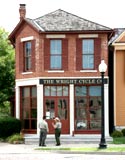
Dayton Aviation Heritage Park
The Dayton Aviation Heritage National Historical Park was established to commemorate the lives of the Wright Brothers and their friend Paul Dunbar. The park complex consists of a number of basic groups located throughout Dayton. The primary locations are:
At the heart of the Dayton Aviation Heritage Nation Historical Park is the Aviation Trail Visitor Center and Parachute Museum. Next door to the Visitor Center is the Wright Cycle Company Complex.
By 1900 Dayton's West Side, which is where the Aviation Heritage Visitor Center is located, was a thriving neighborhood of working-class homes and small businesses. Some residents commuted to downtown Dayton by streetcar. Others, like Wilbur and Orville, lived and worked in the community.
 The brothers walked between their home on Hawthorne Street, one block south of their print shop in the Hoover block and the Wright & Wright Job Printers on the second floor. In the print shop the young brothers printed local circulars and published their own papers and newsletter such as the West Side News. This activity helped instill in the brothers a strong entrepreneurial spirit that they carried with them throughout their entire lives.
The brothers walked between their home on Hawthorne Street, one block south of their print shop in the Hoover block and the Wright & Wright Job Printers on the second floor. In the print shop the young brothers printed local circulars and published their own papers and newsletter such as the West Side News. This activity helped instill in the brothers a strong entrepreneurial spirit that they carried with them throughout their entire lives.
In 1892 the Wrights started a new business, a bicycle shop on West Third Street. Over the next 20 years, in various West Side shops, the brothers designed and built bicycles, and then airplanes. Even after building their mansion in nearby Oakwood, Orville still went to work daily at his West Side laboratory and machine shop.

Self-guided walking tour of the West 3rd Street Historic District
At the American Heritage Visitors Center you can pick up a self-guided walking tour of the "West Third Street and Wright-Dunbar Village Historic Districts. This walking tour will give you the architectural and historical features of buildings in the District.
 The Wright Cycle Company
The Wright Cycle Company
The fourth bicycle shop operated by the Wrights is the only building remaining as testament to the bicycle business. It is also in this shop in which the Wrights' passive interest in flying turned to active research and development. Designated a National Historic Landmark in 1990.
 Huffman Prairie Flying Field Interpretive Center
Huffman Prairie Flying Field Interpretive Center
Exhibits focus on the Wright brothers' development of the world's first practical airplane at Huffman Prairie in 1904 and 1905, their flying school starting in 1910, and the accomplishments of Wright-Patterson Air Force Base.
 Huffman Prairie Field
Huffman Prairie Field
On this 84-acre patch of rough pasture outside Dayton, the Wright brothers learned to control and maneuver their powered machine and taught themselves to fly during 1904 and 1905. Designated a National Historic Landmark in 1990.
 Wright Memorial
Wright Memorial
Adjacent to the Interpretive Center, the Wright Memorial on Wright Brothers Hill is a 27-acre designed landscape honoring Dayton's native sons. The monument, a 17-foot pink granite obelisk, was dedicated on August 19, 1940, Orville's 69th birthday.
 Wright Brothers Aviation Center at Carillon Park
Wright Brothers Aviation Center at Carillon Park
The world's first practical airplane, the 1905 Wright Flyer III, built by the Wright brothers and flown at Huffman Prairie, is the centerpiece exhibit. Designated a National Historic Landmark in 1990 and a Historic Mechanical Engineering Landmark in 2003.
 Paul Laurence Dunbar House
Paul Laurence Dunbar House
Dunbar purchased this house for his mother in 1904 and completed his last work here before his death in 1906. This gifted and prolific writer produced over 400 poems, novels, plays, short stories, and lyrics. Designated a National Historic Landmark in 1977.
Other nearby attractions:
-
Carillon Park
1000 Carillon Blvd., Dayton 45409 -
National USAF Museum
1100 Spaatz Street, Wright-Patterson Air Force Base -
Miamisburg Mound
Conical Indian Mound From the Adena culture -
Dayton Aviation Heritage Park
22 S. Williams St., Dayton, OH 45402 -
Dayton Aviation Heritage Park
22 S. Williams St., Dayton, OH 45402 -
Aullwood Audubon Center
1000 Aullwood Road, Dayton, OH 45414

 Aviation Trail Visitor Center
Aviation Trail Visitor Center

